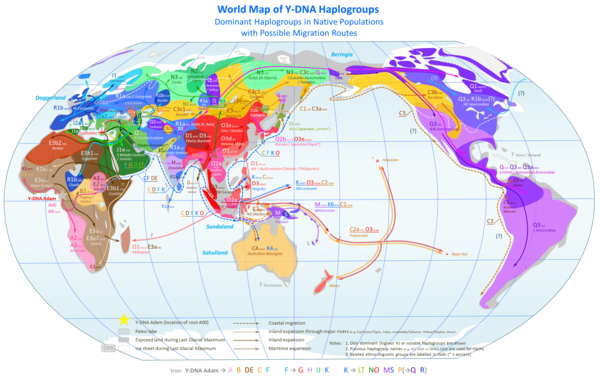Paleolinguistics
As a fringe area of linguistics, paleolinguistics deals with the origin of language and the further development of the language up to the beginning of historical tradition. Helmut Glück describes it as “linguistic research on prehistory”. The term palaeolinguistics appeared in 1968.
history
The question of when and how language first emerged has preoccupied people in Europe since ancient Greece. Arens (1969: 18f.) Deals with this topic several times, beginning with references to Plato, Epicurus and Diodorus. From the perspective of German intellectual history, reference can also be made to Herder's considerations on this (Arens 1969: 123ff.).
One of the authors who dealt with the development of language before the onset of historical tradition was August Schleicher , who published his family tree theory in 1853 . It was taken up by Nikolai Jakowlewitsch Marr in his Japhetite theory . Richard Fester is a new representative of paleolinguistics . The magazine Mother Tongue , which deals with the prehistory of languages, has been published since 1995 .
Problems of Paleolinguistic Research
The methodological problems of paleolinguistics are obvious: If one wants to say something about the origin and development of language in the time before written documents appear, such attempts have a hypothetical character.
The historical linguistics has found ways to close out the oldest attested language states to earlier states of language; the process is called reconstruction and is part of etymological research. It allows reasonably reliable conclusions to be drawn about the original languages of individual language families , for example the Indo-European original language . However, reconstructions are only possible over a period of a few thousand years. Even earlier language states or even the language's origin are not accessible and must remain the subject of speculation.
Disputes
It is disputed whether the original languages of the various language families that have so far been developed can in turn be traced back to common origins. Ruhlen (1994) and the archaeologist Renfrew (1995) believe they can take this step. They assume that all languages developed from a single original language ( monoglottogenesis or monogenesis ). To support their hypothesis, they also refer to findings from human genetics ( Cavalli-Sforza et al. 1988). The not uncontested studies of water and place names indicate a common original language at least in Europe (Hamel & Vennemann 2002). However, the clear majority of historical linguists are unable to follow these arguments because they are convinced that such far-reaching conclusions are not possible with the known methods.

See also
literature
- Elisabeth Hamel: The development of peoples in Europe , research in archeology, linguistics and genetics . Rottenbücher Verlag, Ebersberg 2009. ISBN 978-3-00-027516-6 .
- Hans Arens: Linguistics. The course of their development from antiquity to the present. Second, revised and greatly expanded edition. Verlag Karl Alber, Freiburg / Munich 1969.
- Luigi Luca Cavalli-Sforza , Alberto Piazza, Paolo Menozzi, & Joanna Mountain: Reconstruction of human evolution: Bringing together genetic, archeological, and linguistic data. In: Proceedings of the National Academy of Sciences , Volume 1988, Vol. 85, No. 16, pp. 6002-6002.
- Elisabeth Hamel & Theo Vennemann : The original language of the old Europeans . In: Spektrum der Wissenschaft , May 2002, pp. 32–40.
- Colin Renfrew : The world's linguistic diversity. In: Spektrum der Wissenschaft , July 1995, pp. 70-78.
- Merrit Ruhlen: On the Origin of Languages. Studies in Linguistic Taxonomy. Stanford University Press, Stanford, Cal. 1994. ISBN 0-8047-2321-4 .
Web links
- The Becoming of the Nations in Europe Literature
Individual evidence
- ↑ See Helmut Glück (Hrsg.), With the assistance of Friederike Schmöe : Metzler Lexikon Sprach. 3rd, revised edition. Metzler, Stuttgart / Weimar 2005, ISBN 3-476-02056-8 (keyword: "Palaeolinguistics")
- ↑ A. Marques de Olivera Filho: Um ensaio de paleolinguística. Livraria Academia, Rio de Janeiro 1968
- ↑ The status of the discussion from an anthropological point of view Sebastian Kirchner, J. Richter, B. Wagner: How did the word come to people? In: GeoWissen 40/2007: Language , pp. 86–93. Here it is made very clear how well the distribution of the original languages and the genetic relationship as well as the migratory movements of humanity fit together.